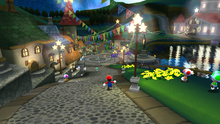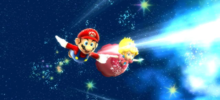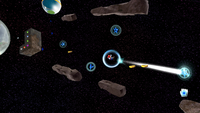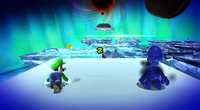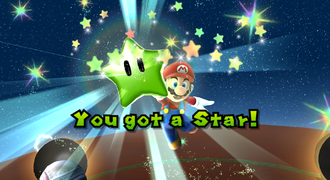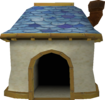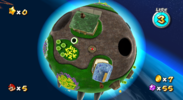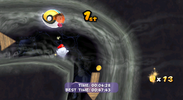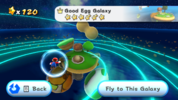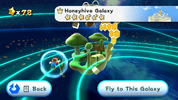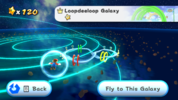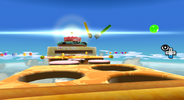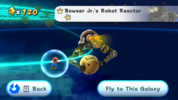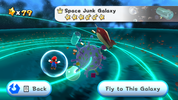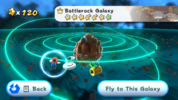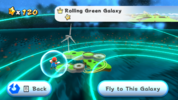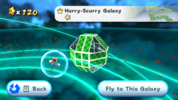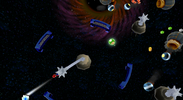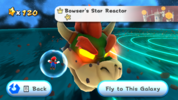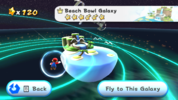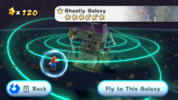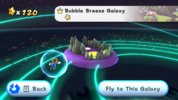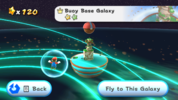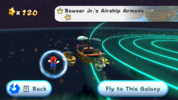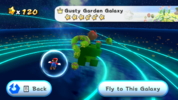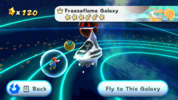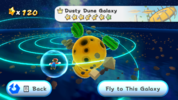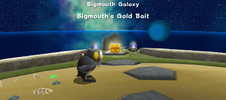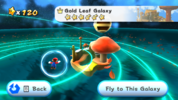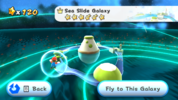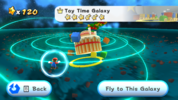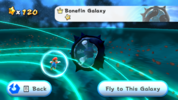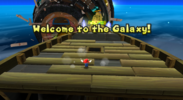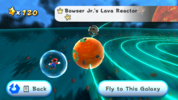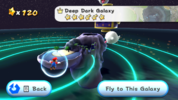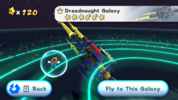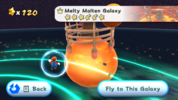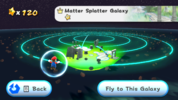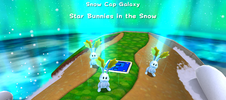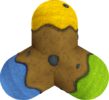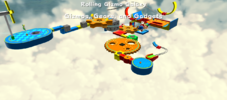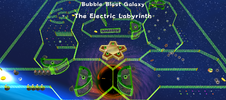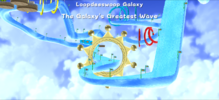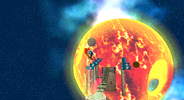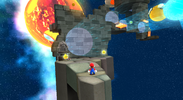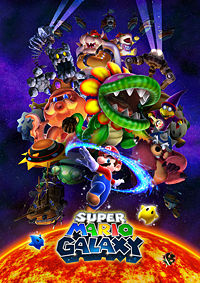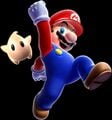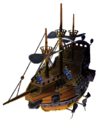Super Mario Galaxy
- "Mario Galaxy" redirects here. For the stage in Super Smash Bros. for Wii U and Super Smash Bros. Ultimate, see Mario Galaxy (stage).
- This article is about the game known as "Super Mario Wii" in South Korea. For the game commonly referred to as "Super Mario Wii" in other regions, see New Super Mario Bros. Wii.
- Not to be confused with Super Galaxy.
Template:Infobox Super Mario Galaxy, known as Super Mario Wii in South Korea, is a 3D action-adventure platformer game for the Wii console, first released in November 2007. It is the third main Mario 3D platformer, and the follow-up to Super Mario 64 and Super Mario Sunshine. However, unlike the previous two 3D adventure installments for the Mario franchise, this game takes place in deep space. Most of the game's levels consist of many small planets and planetoids, while others have bigger planets. Upon release, Super Mario Galaxy received some of the highest review scores and appraisals of any Wii game to date, and of any game overall. Since its release, the game has sold nearly 13 million copies, making it the ninth best-selling Wii game, and earning a Nintendo Selects re-release.[1]
A sequel to this game, Super Mario Galaxy 2, was released in May 2010. A port of the game is bundled in with Super Mario 3D All-Stars for the Nintendo Switch, released in September 2020, featuring the original game with upscaled graphics.[2]
Story
From the instruction booklet
Every hundred years, a huge comet flies by in the skies above the Mushroom Kingdom. One year, that comet filled the entire sky, and from it fell a stream of shooting stars. The Toads scooped up the Star Bits and brought them to the castle, where they were reborn as a great Power Star. It was a happy time in the Mushroom Kingdom. Then one night Mario received a letter...
Dear Mario, I'll be waiting for you at the castle on the night of the Star Festival. There's something I'd like to give you. From Peach
With invitation in hand, Mario headed off to the castle just as the Star Festival was getting into full swing. Surrounded by Toads gleefully trying to catch falling Star Bits, Mario was looking forward to the night's festivities.
But then, something happened...
Every hundred years, on the eve of the Star Festival, a comet passes over the Mushroom Kingdom and causes magical stars and stardust to fall to the planet below. Peach invites Mario to her castle to join in the festivities and receive a special gift. As Mario arrives in the Castle Gardens, Bowser suddenly attacks the Toads with his airships and freezes them in crystals. He "invites" Peach to the creation of his brand new galaxy and lifts the castle off the ground with a UFO to carry it to the center of the universe. Before Mario can reach Peach, Kamek casts a spell at him, sending him into space. A Luma, whom Peach was carrying before her abduction, flees to look for Mario before Kamek warps the castle away with another spell.

When Mario later wakes up on a small grassy planet he meets the Lumas and eventually Rosalina, a mysterious woman who acts as the protector of the galaxies and the mother of the Lumas. She tells Mario that her ship, the Comet Observatory, had its Power Stars and Grand Stars stolen by Bowser. Without these, the Comet Observatory is unable to move through space. Rosalina asks him to rescue the Grand Stars in order to defeat Bowser. Mario also receives help from a Luma who grants him spinning powers. Mario and Luma complete missions from galaxies in opened domes in order to receive Power Stars. Once a mission is completed, Mario collects a Power Star and unlocks the next mission. There are normally five galaxies per dome, and once Mario has collected enough Power Stars, the next galaxy in the current dome would be an enemy base where either Bowser or Bowser Jr. would be using the power of one of the Grand Stars. His next mission would be to defeat Bowser or Bowser Jr. and rescue the next Grand Star. Rescuing the Grand Star unlocks the next dome. When enough Power Stars and Grand Stars are collected, the Comet Observatory takes Mario to the center of the universe.
Here, Mario defeats Bowser in his brand new galaxy, retrieves the last Grand Star, and rescues Peach. Just then, one of the planets of Bowser's near-complete galaxy undergoes a supernova and becomes a supermassive black hole which begins pulling in everything. The Lumas from the Comet Observatory, including the Luma who had accompanied Mario throughout his adventure, throw themselves into the black hole in order to neutralize it, and it soon disintegrates in a massive explosion. Mario appears in front of Rosalina, who saves him from the cataclysm and tells him that this is not the end, but a new beginning for the universe, which repeats its cycle, albeit imperfectly.
Mario later awakens in the Mushroom Kingdom near Peach's Castle. He sees everyone he has met throughout his adventure celebrating, while Bowser and Peach lie next to him with no recollection of the past events. When he looks in the air, he notices the reconstructed galaxy, and exclaims "Welcome! Welcome new galaxy!" as the camera zooms out into space, revealing the reconstituted universe. If 120 Power Stars are collected, a special cut scene plays after the credits: Rosalina thanks the player and says "I will watch over you from beyond the stars." before flying off with the Comet Observatory. The Luma that accompanied Mario is shown to be alive, left behind by Rosalina inside a derelict Starshroom on a small planet. This alludes to the idea of how the universe repeats itself, as Rosalina will be reborn and find Luma searching for its mother some time in the future, and the events of Rosalina's storybook occur again.
Gameplay
Basic gameplay
Gameplay is somewhat different from the previous Mario titles, as rather than being played strictly in 2D or 3D, the game occasionally shifts from 3D to 2D and vice versa (although the core gameplay is largely in 3D); the game also utilizes sphere walking. Even with these changes, however, the gameplay heavily resembles Super Mario 64 and Super Mario Sunshine, with a similar camera system and similar gameplay mechanics.
Basic controls
The game has several innovations and additions to the basic 3D Mario game concept. Mario is controlled with the analog stick and can jump with the ![]() . The
. The ![]() works just as the
works just as the ![]() trigger did in Super Mario 64. The player uses it to make Mario crouch, do Backwards Somersaults, Side Somersaults, and Long Jumps. Mario can also Triple Jump by jumping with precise timing three times, each time jumping higher than before. The
trigger did in Super Mario 64. The player uses it to make Mario crouch, do Backwards Somersaults, Side Somersaults, and Long Jumps. Mario can also Triple Jump by jumping with precise timing three times, each time jumping higher than before. The ![]() centers the camera behind Mario, while the
centers the camera behind Mario, while the ![]() can adjust the camera angle manually. By pressing
can adjust the camera angle manually. By pressing ![]() , the player can enter a first person perspective.
, the player can enter a first person perspective.
The game also uses the motion-sensors of the Wii Remote. The pointer of the Remote appears as the Star Cursor on the screen. The Star Cursor is used to perform a variety of actions, such as using Pull Stars, manipulating Sling Pods, and collecting Star Bits. Shaking the Wii Remote or Nunchuk makes Mario perform a Spin.
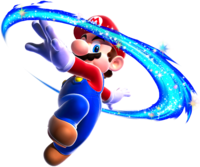
By pressing ![]() , players can fire a Star Bit. When enemies are hit by a Star Bit, they are stunned and can be defeated with a touch, releasing Star Bits. Mario can also defeat most enemies by jumping on them, which creates a healing coin. Using the Spin to defeat enemies is also possible. Spinning may also stop an enemy from attacking; if Bowser and Mario both Star Spin at the same time, both moves get canceled. Also, if Mario or Luigi Long Jumps then lands on the ground and quickly does a Spin, they will do a small pirouette. The player can use any of these tactics or only one of them during the entire game, as a specific tactic is never required to defeat a regular enemy. Only special enemies such as the Big Goomba in the Gateway Galaxy might require a Spin. Several enemies are, however, much easier to defeat by shooting them than by jumping on them. As in Super Mario Sunshine, Mario can jump on NPCs to gain extra height or annoy them.
, players can fire a Star Bit. When enemies are hit by a Star Bit, they are stunned and can be defeated with a touch, releasing Star Bits. Mario can also defeat most enemies by jumping on them, which creates a healing coin. Using the Spin to defeat enemies is also possible. Spinning may also stop an enemy from attacking; if Bowser and Mario both Star Spin at the same time, both moves get canceled. Also, if Mario or Luigi Long Jumps then lands on the ground and quickly does a Spin, they will do a small pirouette. The player can use any of these tactics or only one of them during the entire game, as a specific tactic is never required to defeat a regular enemy. Only special enemies such as the Big Goomba in the Gateway Galaxy might require a Spin. Several enemies are, however, much easier to defeat by shooting them than by jumping on them. As in Super Mario Sunshine, Mario can jump on NPCs to gain extra height or annoy them.
Swimming is fairly simple. Mario can change his direction by using the analog stick and can dive by pressing Z. Breaststrokes are possible by pressing A repeatedly while swimming forward. Mario must return to the surface or collect air bubbles periodically in order to refill his air supply. Failure to do so could result in losing a life.
Skating is a technique used when on ice. Mario merely needs to spin while walking, and he starts to skate.
There is also a move that is not explained in the instruction booklet. If the player, while airborne, both shakes the controller and presses ![]() (to spin and Ground Pound at the same time), they perform a special ground pound that homes in on nearby enemies. If there is no enemy nearby, Mario does a fancier ground pound. This move returns in the game's sequel, also unexplained in the packaged materials.
(to spin and Ground Pound at the same time), they perform a special ground pound that homes in on nearby enemies. If there is no enemy nearby, Mario does a fancier ground pound. This move returns in the game's sequel, also unexplained in the packaged materials.
Co-Star Mode
Featured in Super Mario Galaxy is a multiplayer mode named Co-Star Mode. By simply connecting a second Wii Remote, another player can join in and assist the first player by controlling a second Star Cursor, and in doing so can accomplish a variety of different things, some of which the first player can do, but many of which the first player cannot do. When Co-Star Mode is active, "1P" appears below Player 1's Star Cursor, and "2P" appears below Player 2's Star Cursor to help differentiate between them. When Co-Star Mode is not in use, these indicators no longer appear beneath either player's Star Cursors, until such time as Co-Star Mode becomes active again. The second player can collect Star Bits and fire them at enemies to briefly stun them. When the second Star Cursor is pointed at Mario and ![]() is pressed, the second player can make Mario perform a Co-Star Super Jump. Combining both jump techniques can make Mario jump higher than when only controlled with one controller. This works in midair, but can only be done once before touching a horizontal surface.[3]
is pressed, the second player can make Mario perform a Co-Star Super Jump. Combining both jump techniques can make Mario jump higher than when only controlled with one controller. This works in midair, but can only be done once before touching a horizontal surface.[3]
Mario's life meter
Mario's life meter has been decreased to three total. Originally, Mario had a life meter with 8 units, similar to Super Mario 64, its DS remake and Super Mario Sunshine, but it was reduced to 3 in the final game, with the ability to extend it to a maximum of 6, via a Life Mushroom. There is no longer a separate health bar for underwater levels which decreases slowly. Instead, Mario has an air meter which decreases and hurts Mario's health when it hits zero. The Life Mushroom replenishes any lost health and adds a second health meter, making Mario's max health six. When Mario's health drops down to three again, the second health meter smashes and the effect of the Life Mushroom is lost.
New elements
Mario explores a 3D world with planets which have their own gravity. Several levels have arrows which Mario can turn around with a Spin, changing the direction of the gravity. The Launch Star allows Mario to launch off of a planet and go flying to the next. There is little or no warning that a boss might be located on the next planet, and there is also little indication that Mario may be facing something terrible or something peaceful on where he is headed next, and there are also no loading times and screens. The game also contains side-scrolling levels reminiscent of New Super Mario Bros. with classic enemies such as Goombas and Piranha Plants. These side-scrolling levels may also contain directional gravity, allowing Mario to walk on the walls and ceiling.
"Super Luigi Galaxy"
Collecting all 120 Power Stars and defeating Bowser once more unlocks "Super Luigi Galaxy" mode, which replaces Mario with a playable version of Luigi and presents a few gameplay differences to reflect this change. Like in a number of previous Mario games, Luigi boasts higher jumps, but lower traction compared to Mario. Luigi is also faster than Mario, but takes longer to reach top speed. Luigi loses air faster while underwater and loses a chunk of air every time he spins underwater. Cosmic Luigi is more challenging than Cosmic Mario, and Luigi receives 20 1-Up Mushrooms from Peach's letter (although if Luigi's 1-Up counter grows too high, he only receives five). Outside of these changes, the storyline is almost completely unchanged, and even includes the original NPC Luigi. When players collect 120 Power Stars and defeat Bowser again in this mode, Grand Finale Galaxy becomes available for both Mario and Luigi, allowing the 121st Power Star to be collected.
This mode is referenced by Rosalina as "another world" players can access once they have defeated Bowser after collecting 120 Power Stars. In the Japanese version, she describes it as the world where Mario (or Luigi) may come across his alternate self who is not him.[4]
Controls
 : Jump/swim
: Jump/swim : Fire Star Bit
: Fire Star Bit (shake): Spin
(shake): Spin : Move
: Move (grounded): Crouch
(grounded): Crouch (midair): Ground Pound
(midair): Ground Pound : Center camera
: Center camera : Move camera
: Move camera : First-person view
: First-person view (shake midair) +
(shake midair) +  : Homing Ground Pound
: Homing Ground Pound
Note: Since the Nvidia Shield controller does not have motion controls, the spin is performed by pressing the X button, while the right analog stick is used to move the Star Cursor. In the case of Player 2, both analog sticks can be used to control the Star Cursor.[5] The original tilt controls in the game is also replaced by the regular left analog stick control.[6]
Galaxies
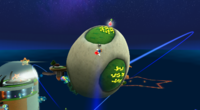
Power Stars make a comeback, last being seen in Super Mario 64. The main goal of the game is to collect a minimum of 60 stars and defeat Bowser. Similar to Peach's Castle in Super Mario 64 and Delfino Plaza in Super Mario Sunshine, the Comet Observatory acts as the game's hub area. There, Mario can access the galaxies from domes. New areas in the Comet Observatory become accessible as Mario gains Power Stars and Grand Stars. A minimum number of Power Stars is required to have enough power to go to each multi-star galaxy, single non-Grand Star galaxies with a ? Block icon when locked are bonuses for finishing certain star missions. At the end of each dome, the player enters a galaxy where they alternate between fighting Bowser Jr. and Bowser, represented by Bowser's head on the world map (though after a Bowser Jr. galaxy is cleared, the head changes into the actual galaxy itself). The game has a level intro for each star, as in Super Mario Sunshine.
Mario encounters Luigi in four levels (located in the Good Egg Galaxy, the Honeyhive Galaxy, the Battlerock Galaxy, and the Ghostly Galaxy). In Ghostly Galaxy, Luigi is at the end of Luigi and the Haunted Mansion holding a star. After Luigi is rescued, he can be seen in the observatory and helps Mario reach secret stars that he could not get alone. When Luigi is in other galaxies, Mario receives a letter from Luigi every time Luigi has found a Power Star, including a picture which helps Mario find Luigi. After the main game is finished, Mario can return and collect up to 120 stars. Super Mario Galaxy contains a few different types of stars, including red, green, and comet stars. The Green Stars are secret stars which are used to unlock the Trial Galaxies and one Red Power Star appears when Mario returns to the gate, which allows usage of the Red Star in the Comet Observatory.
After finishing a level, Mario's highest score of coins for the galaxy is recorded and the collected Star Bits are transferred to the Comet Observatory, where Mario can later use them to feed Hungry Lumas. The requirements for opening up each galaxy is listed below, with Star Bits if the galaxy is created by a Hungry Luma. Note, however, that some galaxies are not unlocked by simply obtaining a number of stars but by completing a specific star. This is true for all Hungry Lumas except the first, and all bonus galaxies from Buoy Base Galaxy onward.
There are a total of forty-two galaxies in the game.
The amount of Power Stars and Star Bits listed after a galaxy is the amount of the corresponding collectibles that is required to unlock the galaxy.
Galaxies marked with an asterisk (*) are unlocked by feeding Hungry Lumas. Missions marked in green are Green Star missions, orange are Grand Star missions, cyan are Prankster Comets, pink are secret missions, and red is the single Red Power Star mission.
Prankster Comets
- Main article: Prankster Comet
Prankster Comets are objects which interfere with a Galaxy, giving it an extra attribute. The 30 comet stars are obtained by completing special challenges in the major galaxies, such as speed runs of certain missions, "daredevil" runs (in which Mario is defeated if he takes a single hit), racing cosmic clones of Mario or Luigi, and doubling the speed of enemies and obstacles. They only appear after the corresponding regular level (e.g. Ghostly Galaxy's Bouldergeist battle) is completed, sometimes immediately, and at other times, only after another galaxy's level is completed. Prankster Comets appear and disappear every other level completed. After a level is completed while a Prankster Comet is active, all the Prankster Comets are removed until yet another level is beaten. In some cases (like the Space Junk Galaxy), the entire galaxy has to be beaten first. There are two Prankster Comets in each of the 15 major galaxies: one of the comet types just described, plus one purple prankster comet that appears after beating Bowser's Galaxy Reactor for the first time, forcing missions where the player must collect 100 Purple Coins.
Characters
Playable characters
| Name | Description |
|---|---|
 Mario |
The hero of the Mushroom Kingdom and the game's protagonist. After being invited to celebrate the Star Festival at Peach's Castle, an abduction cuts the party short and leaves Mario isolated on another planet far from home. It is here that he meets an apricot-colored Luma and his caretaker - the mysterious Rosalina. With the Luma bestowing him with the power to travel through space, Mario strives to collect Power Stars, rescue Princess Peach, and stop Bowser from creating his galactic empire at the center of the universe. His movement options and overall feel are more directly comparable to Super Mario 64 than they are to the previous 3D Super Mario game. |
 Luigi |
Mario's younger twin brother. He can be used to replay the game after collecting 120 Power Stars and completing "The Fate of the Universe" as Mario. He can jump higher and run faster than Mario, but at the cost of reduced traction and increased startup. This causes Luigi to skid as he moves, and increases the risk of him falling off of a platform or colliding with an obstacle. He otherwise appears as a supporting character who will go on quests to collect Power Stars for his brother. He will still fulfill this supporting role during Luigi's playthrough, leading to a situation where there are two of them. Luigi can be quite cowardly and is deathly afraid of ghosts. |
Non-playable characters
With the exception of Princess Peach, Toads, and Penguins, all of the characters encountered by the player are completely new to the Mario series. Most characters are met in various galaxies, though Rosalina, the Toad Brigade, and the Lumas are found on the Comet Observatory.
| Name | Description | Locations |
|---|---|---|
 Apricot Luma |
Mario's traveling companion - a young Luma who resides under his cap. He grants Mario[note 1] the ability to Spin and travel through space. Before being kidnapped, Princess Peach was going to give this Luma to Mario as a gift during the Star Festival. It is implied that he is a reincarnation of the first Luma that Rosalina ever encountered. | All galaxies |
 Princess Peach |
The ruler of the Mushroom Kingdom. She was kidnapped by Bowser on the night of the Star Festival and taken to the center of the universe. The game follows Mario's quest to save her. She will periodically send letters of encouragement to Mario that contain 1-Up Mushrooms and will do so even during Luigi's playthrough. Rosalina refers to Peach as Mario's "special one". | Bowser's Galaxy Reactor Grand Finale Galaxy[note 2] |
 Rosalina |
A mysterious woman who serves as the guardian of the cosmos. She travels through space via the Comet Observatory, a vessel she built for the Lumas. It was abruptly stopped and stripped of its power source, the Power Stars, by Bowser. Rosalina makes an arrangement with Mario to collect Power Stars and restore power to the observatory. In return, she will help him stop Bowser and rescue Princess Peach. Her past is revealed to the player as they accumulate Power Stars via Rosalina's Storybook. The Lumas recognize Rosalina as their mother, who in return sees them as her family. | Comet Observatory Gateway Galaxy |
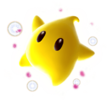 Lumas |
Star children that make their home in the Comet Observatory. Lumas appear in some galaxies to aide Mario, typically by transforming into Launch Stars. Lumas become celestial bodies when they grow up, and which one is dependent on their color. Lumas eat Star Bits and squeal with delight when fed via the Star Cursor. | Comet Observatory Good Egg Galaxy Battlerock Galaxy Bowser's Star Reactor Bowser Jr.'s Airship Armada Bowser's Dark Matter Plant Gateway Galaxy Dreadnought Galaxy Bowser's Galaxy Reactor |
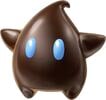 Polari |
An elderly Luma who serves as Rosalina's advisor. He appears within each dome of the observatory and will grant access to the map when prompted. He teaches the player how to use the Star Cursor. | Comet Observatory |
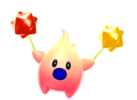 Hungry Lumas |
Big, voracious Lumas that will transform into galaxies or planets when fed a specified number of Star Bits. The newly-formed celestial body always contains a hidden Power Star. | Comet Observatory Good Egg Galaxy Space Junk Galaxy Battlerock Galaxy Dusty Dune Galaxy Sea Slide Galaxy Toy Time Galaxy Melty Molten Galaxy |
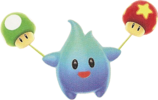 Lumalee |
A big Luma that runs the Luma Shop. He typically proceeds a boss encounter and will transform into a Mushroom of choice in exchange for thirty Star Bits. | Battlerock Galaxy Ghostly Galaxy Bowser Jr.'s Airship Armada Melty Molten Galaxy Dreadnought Galaxy |
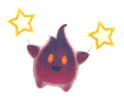 Comet Tico |
A big Luma that is knowledgeable about Prankster Comets. He provides details on these comets to the player when prompted. Alternatively, he can shift where a Prankster Comet appears in exchange for twenty Star Bits. | Comet Observatory |
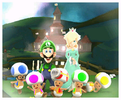 The Toad Brigade |
A five-member team of Toads on a quest to help find Princess Peach. They travel through space in search of Power Stars on a starship called a Starshroom. The Lumas built it for them. There are three Toads other than the red-capped leader and purple-capped postman that are part of the Brigade. There is a knowledgeable Blue Toad who typically provides information on an area of interest; a Green Toad who wields a pickaxe and constructs cannons for Mario; and a very sleepy Yellow Toad. | Comet Observatory Honeyhive Galaxy Sweet Sweet Galaxy Space Junk Galaxy Hurry-Scurry Galaxy Bubble Breeze Galaxy Ghostly Galaxy Bowser Jr.'s Airship Armada Freezeflame Galaxy Dusty Dune Galaxy Bigmouth Galaxy Sea Slide Galaxy Toy Time Galaxy Sand Spiral Galaxy Deep Dark Galaxy Grand Finale Galaxy |
 Toad Brigade Captain |
The captain of the Toad Brigade. This Red Toad self-designated himself as the brigade captain and typically sends his teammates into dangerous situations without his direct involvement. According to the Blue Toad, the captain is the most cowardly member of the team. | All galaxies that feature the Toad Brigade |
 Mailtoad |
A member of the Toad Brigade who runs a postal service for Mario on the Comet Observatory. He will deliver mail from Princess Peach or Luigi. When out on missions with the brigade, he typically is equipped with a snorkel. | All galaxies that feature the Toad Brigade |
 Star Bunnies |
Spacefaring rabbits that like to play tag and hide-and-seek. They will award Mario a Power Star for catching them. The Star Bunnies of Gusty Garden Galaxy have a penchant for gardening and are hunted by Undergrunts. Some Star Bunnies are Lumas in disguise. Unlike them, the real rabbits often end their sentences with "boiyoing" or sport Toad-like vests. | Gateway Galaxy Bowser Jr.'s Airship Armada Gusty Garden Galaxy Gold Leaf Galaxy Snow Cap Galaxy Grand Finale Galaxy |
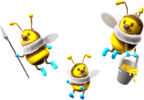 Honeybees |
Bee people that collect honey. They teach the player how to use their bee form. Most Honeybees are members of the Honeyhive Kingdom and are in the midst of a dispute with a society of stink bug-like Mandibugs. The bees of Gold Leaf Galaxy keep Cataquacks as pets. | Honeyhive Galaxy Sea Slide Galaxy Gold Leaf Galaxy Grand Finale Galaxy |
 Queen Bee |
The ruler of the Honeyhive Kingdom. Her body can be clung to by the player. Queen Bee's gentle and calm disposition contrasts with her imposing size. | Honeyhive Galaxy |
 Boards |
Talking boards that will call out to Mario and teach him unique mechanics. Different individuals will teach different things: Gil Board teaches Mario how to Wall Jump; Bill Board teaches him how to use the Star Ball; Phil Board teaches him how to use the Bubble; and Jill Board will remind him how to use his Boo form. | Honeyhive Galaxy Rolling Green Galaxy Bubble Breeze Galaxy Gusty Garden Galaxy Melty Molten Galaxy Boo's Boneyard Galaxy Rolling Gizmo Galaxy Bubble Blast Galaxy Grand Finale Galaxy |
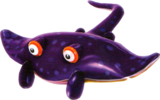 Ray |
The Manta that Mario surfs on during the Ray Surfing minigame. Safely reaching the finish line within a specified time limit awards Mario with a Power Star. | Loopdeeloop Galaxy Loopdeeswoop Galaxy |
 Penguins |
Carefree, flightless birds who love swimming. Some individuals will share swimming techniques with Mario when prompted, while others will try to play with him. Most penguins are young birds that are a little shorter than Mario, but there are two adults in the game that tower over him. | Loopdeeloop Galaxy Beach Bowl Galaxy Buoy Base Galaxy Drip Drop Galaxy Freezeflame Galaxy Bigmouth Galaxy Sea Slide Galaxy Loopdeeswoop Galaxy Grand Finale Galaxy |
 Coach |
A big penguin that teaches young birds how to swim. He has a kind and paternal disposition. Coach is the host of the Ray Surfing minigame and will give Mario a tutorial on how to move Ray. | Loopdeeloop Galaxy Beach Bowl Galaxy Loopdeeswoop Galaxy Grand Finale Galaxy |
 Penguru |
A knowledgeable, elderly penguin who likes to fish. While he oversees young penguins, he prefers spending time by himself. | Drip Drop Galaxy Bigmouth Galaxy Sea Slide Galaxy Grand Finale Galaxy |
 Penguin Racers |
A competitive, four-member swimming team of young penguins. While most penguins have blue plumage, each member of this team is a different color. They will challenge Mario to a race when prompted. The team captain - a red penguin with yellow, brow-like feathers - will award Mario a Power Star for outswimming them. | Sea Slide Galaxy Grand Finale Galaxy |
 Gearmos |
Maintenance robots with an obsession for orderliness. Many Gearmos can be found upkeeping battle stations affiliated with the malicious Topman Tribe, but they themselves are kind robots. The Gearmos of Toy Time Galaxy will teach the player how to make the most out of their spring form. An overworked individual hosts the Bob-omb Blasting minigame. Another helps maintain the Comet Observatory's Engine Room. | Comet Observatory Battlerock Galaxy Buoy Base Galaxy Toy Time Galaxy Dreadnought Galaxy Grand Finale Galaxy |
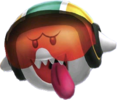 The Spooky Speedster |
A Big Boo in a helmet. He will challenge Mario to race through open space when prompted. He will begrudgenly give Mario a Power Star if he reaches the finish line before him. | Ghostly Galaxy Boo's Boneyard Galaxy |
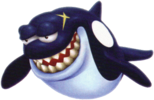 Guppy |
A fearsome orca whale who bullies the penguin racers. He will only relent if Mario can pass through his eight-ring swim challenge, as well as award him a Power Star. Unlike most other characters, Guppy cannot be jumped on and - while not damaging - will knockback Mario if approached. | Sea Slide Galaxy Deep Dark Galaxy |
 Cosmic Mario |
An entity that takes on the form of Mario and has all of the same abilities. It will challenge him to a footrace to a Power Star. It only appears when a Cosmic Comet is in orbit during Mario's playthrough. Making contact with Cosmic Mario during the race will make it release Star Bits. | Honeyhive Galaxy Freezeflame Galaxy Gold Leaf Galaxy Sea Slide Galaxy |
 Cosmic Luigi |
An entity that takes on the form of Luigi and has all of the same abilities. Mirroring Cosmic Mario, it only appears when a Cosmic Comet is in orbit during Luigi's playthrough. It is a more challenging opponent than Cosmic Mario. | Honeyhive Galaxy Freezeflame Galaxy Gold Leaf Galaxy Sea Slide Galaxy |
Enemies and obstacles
The game has old enemies such as Goombas from Super Mario Bros. and Piranha Plants, enemies which make their 3D platformer debut such as Magikoopas and Dry Bones, as well as new enemies, which include the Electrogoombas and Mandibugs.
New enemies and obstacles
| Image | Name | Description |
|---|---|---|

|
Ball Beamer (bolt) | Mechanical enemies which emit circular shockwaves that need to be jumped over in order to be dodged. Bolted Ball Beamers can be unscrewed, opening up the inside of the planet they sit on. |

|
Ball Beamer (nut) | Ball Beamers with nuts sit opposite bolted Ball Beamers on circular planets. Ball Beamers without screws are immune to damage. |

|
Banekiti | Extremely rare spring creatures that only appear in Boo's Boneyard Galaxy. If Boo Mario/Luigi touch the Banekiti, they get bounced away. |

|
Bat | Bats dive towards Mario or Luigi when they get close. They can be defeated with a spin or stomp. |
| Black hole | Black holes suck Mario or Luigi in when they get in range, resulting in an instant life lost. Black holes typically fill in bottomless pits where Mario or Luigi can otherwise fall to their death. | |

|
Bomb Boo | Explosive black Boos which only appear in the Ghostly Galaxy. Unlike normal Boos, Bomb Boos are not shy and charge towards Mario or Luigi when approached. When spinning near a Bomb Boo, they can be grabbed by the tongue to swing into obstacles. Bomb Boos are summoned by Bouldergeist, and can be used to destroy the boss's stone armor. |

|
Clampy | Predatory clams which store Star Chips and coins in their shells, intending to lure Mario or Luigi in and catch them in their mouths. |

|
Cluckboom | Red chickens which lay explosive eggs, only appearing in the Dusty Dune Galaxy. Cluckbooms can be defeated by shooting them with a Star Bit, bringing them to the ground where they can be kicked or stomped on. |

|
Crabber (turquoise) | Cowardly crab enemies which frantically scuttle around, producing a 1-Up Mushroom when defeated. Crabbers possess a shell which protects them from jumps and spins head-on, but they can be defeated by spinning at their fleshy rear. |

|
Crabber (red) | Unlike their turquoise counterparts, red Crabbers directly move in to attack Mario or Luigi, but are easier to defeat because they move slowly. |

|
Dark matter | Purple, poisonous ooze which disintegrates Mario and Luigi upon contact. There are also translucent patches of dark matter which create cavities in moving platforms. Dark matter only appears in Bowser's Dark Matter Plant. |

|
Electric sphere | Metal orbs which move in a circle, causing Mario or Luigi electrical damage if touched. |
| Electrogoomba | Alien Goombas which attempt to headbutt Mario or Luigi when they get in range. Electrogoombas can be defeated by spinning them once or jumping on their heads. | |

|
Eye Beamer | Mechanical eyes which emit an electrical beam, damaging Mario or Luigi on impact. Some Eye Beamers move while others are stationary, meaning that they can occasionally be used as a platform to traverse obstacles. |

|
Fire Pressure | Fire-emitting cannons which either shoot a stream of flames or shoot fireballs. |

|
Flipbug | Cowardly Mandibug-like creatures which chase Bee Mario/Luigi, but retreat from them and stumble over in their regular forms. If approached when upright and then spun, Flipbugs fall upside down, allowing them to be kicked or stomped on. |

|
Giant prickly plant | Giant versions of prickly plants which cause damage upon contact. They can be defeated by spinning a coconut or a rubbery bulb into them. |

|
Gold Chomp | A single golden Chomp appears in the Gusty Garden Galaxy. A Rainbow Star is needed to break through it, releasing a Power Star. |

|
Goombeetle | Goombas wearing steel helmets, granting them immunity to being stomped. In order to defeat Goombeetles, they need to be spun upside down and stomped on. |

|
Gringill | Large eels which either swim in bodies of water or lurk in caves, stretching out to bite Mario or Luigi. Gringills can be defeated by throwing a Shell at them. |

|
Gringill (big) | Giant Gringills which solely appear in caves. When defeated, they produce a 1-Up Mushroom. |

|
Honey | Puddles of honey which slow Mario or Luigi down when they set foot in them. |

|
Ice bat | Ice-elemental bats which can only be defeated with the aid of a Fire Flower. |

|
Ice Bubble | Ice-elemental enemies predominantly found in Freezeflame Galaxy, freezing Mario or Luigi on contact. Spinning near them will neutralise their icy cloud, leaving them vulnerable to being kicked. However, Stunned Ice Bubbles will make toward a pool of freezing water in order to regenerate their cold aura. |

|
Jammyfish | Small jellyfish-like enemies which swim around in groups, hurting Mario or Luigi upon contact. |

|
Jellyfish | Giant, static jellyfish which cause electrical damage upon contact. Jellyfish can be defeated by throwing two Shells at them. |
| Jump Beamer | Spring-like robots which create circular shockwaves. Jump Beamers can also be used as springs when stunned, allowing Mario or Luigi to reach certain areas. | |

|
Jump Guarder | A single Jump Beamer-like enemy which releases four Topminis out of its sides. When stunned, the Jump Guarder can be used as a spring to reach higher areas. It only appears in the Buoy Base Galaxy. |

|
Lava Bubble | Blue Lava Bubbles which hop towards Mario or Luigi. Lava Bubbles first appear when King Kaliente summons them in his boss battle, and later occasionally appear in volcanic galaxies, jumping out of lava to chase the player. They can only be defeated by shooting them with a Star Bit. |

|
Li'l Cinder | Fire-elemental enemies predominantly found in Melty Molten Galaxy. If touched, they cause Mario or Luigi to hop around and run uncontrollably. Spinning near them will extinguish their flame and leave them vulnerable to being kicked. However, extinguished Li'l Cinders will hop towards a pool of lava in order to relight their flames. |

|
Mandibug | Stag beetle-like enemies which quickly charge towards Mario or Luigi in a straight line. They can be defeated by Ground Pounding them on their backs, as indicated by the symbol on their shells. |

|
Mecha-Bowser | Fire-breathing robotic Koopas which can only be defeated with a Ground Pound. Spinning them will briefly delay their fire breath attack. |

|
Mini Wanwan | Small Chomps which roll out of doghouses in the Dreadnought Galaxy. |

|
Monty | Bandana-wearing moles which hide in hatches and throw wrenches at Mario or Luigi. Montys can be stunned by Ground Pounding near them or shooting them with a Star Bit, and then defeated by stomping or spinning them. |
| Octoguy | Pink octopus-like enemies which chase Mario or Luigi and spit rocks when at a safe distance from them. Octoguys are easily defeated with a spin or jump attack, but appear in large groups. | |
![Artwork of a Rocto from Super Mario Galaxy.[1] It has subsequently been used for Super Mario Galaxy 2. This specific image was scanned from its guidebook by Shokora (talk).](https://mario.wiki.gallery/images/thumb/9/94/SMG_Octopus_Artwork.png/51px-SMG_Octopus_Artwork.png)
|
Octopus | Giant Electrogoomba-like enemies which hide in barrels and shoot fireballs at Mario or Luigi. However, they also spit coconuts, which can be deflected with a spin to defeat them. Octopuses are always fought in pairs. |
| Petapeta | Sandal-wearing sack creatures which possess the ability to turn invisible when running. Petapetas are harmless, but can be defeated to recover a large number of Star Bits. | |

|
Prickly plant | Prickly plants which damage Mario or Luigi upon contact. |

|
Prickly plant (floating) | Floating versions of prickly plants. |

|
Pumpkinhead Goomba | Pumpkin-wearing Goombas which can produce blue flames on the ground to harm Mario or Luigi. Pumpkinhead Goombas can be defeated in one hit with a Ground Pound, or spinning them to destroy their pumpkin, turning them into a regular Goomba. |

|
Ring Beamer | Spiked machines which emit circular lasers. The lasers cause electrical damage and should be jumped over to be avoided. |
| Rubbery bulb | Bulb-like plants which stretch in the opposing direction when spun. Rubbery bulbs can be used to hit enemies or obstacles, but can also cause Mario or Luigi to lose their Star Bits if the bulb rebounds and hits them. | |

|
Sentry Beam | Stationary robots which shoot electric lasers from their mouths. Sentry Beams are completely invincible, although standing on top of them will temporarily stun them. |

|
Skeletal Fish Guard | Skeletal fish which aid Kingfin in its fight with Mario and Luigi. Skeletal Fish Guards charge towards the player and tackle them. They can be defeated by leading them to the water's surface, and disappear once Kingfin is defeated. |

|
Slurple | Leech-like enemies which latch on to Mario or Luigi and gradually drain their health. Slurples are easily disposed of with a spin attack. |

|
Spiky Topman | Robotic top enemies which spin into Mario or Luigi. Spiky Topmen cannot directly harm the player, but can push them into a hazard such an electric rail or a bottomless pit. The spike on their heads makes them fully immune to being stomped on. Mario or Luigi can only defeat Spiky Topmen by spinning them into an electric rail. |
| File:Prickly Piranha Plant Galaxy.png | Spiny Piranha Plant | Giant Piranha Plants which forcefully slam their heads into the ground. They can be defeated by jumping on their heads, or stunned by spinning into them. |

|
Spoing | Spider-like creatures which hop up and down on the spot. To defeat Spoings, they can be stunned with a Star Bit and kicked, or simply jumped on. |

|
Sprangler | Spoing relatives which hand from a thread, attempting to swing into Mario or Luigi. Sprangler are defeated by spinning into them twice or by stomping them. |

|
Spring Topman | Green Topmen which act similarly to their red cousins, but reveal a spring when stunned with a spin. Their spring can be used to propel Mario or Luigi up to high ledges. |

|
Steam jet | Jets of steam which set Mario or Luigi aflame if touched. |

|
Topmini | Tiny yellow robots that can be defeated by spinning into them. Topminis are incapable of damaging Mario or Luigi and can only push them around. |

|
Tweester | Tornado-like creatures that can catch Mario or Luigi in their winds, and send the player flying when they spin to escape. Some Tweesters carry rocky debris, allowing them to harm Mario or Luigi when they make contact. |
| Undergrunt | Overweight moles wearing military helmets, which leave a trail of mud behind as they burrow through the ground. They can be defeated by Ground Pounding the floor, forcing them to come to the surface where they can be spun. | |

|
Urchin (land) | Red urchins which roll into Mario or Luigi. They are immune to spinning or being stomped, but can be defeated with a fireball as Fire Mario/Luigi. |

|
Water Shooter | Cannons which shoot bubbles that capture Mario or Luigi and launch them, which can either act as a hindrance or occasionally transport them to a new location in the level. |
Returning enemies and obstacles
| Image | Name | Description |
|---|---|---|

|
Amp | Smiling black balls which emit electricity, often moving in a circular pattern. |

|
Banzai Bill | Gigantic Bullet Bills which only appear in Bowser's Galaxy Reactor. Unlike their smaller relatives, Banzai Bills can only move in a straight line. |

|
Banzai Bill Cannon | Large, stationary cannons which fire Banzai Bills. They only appear in Bowser's Galaxy Reactor. |

|
Big Amp | Larger versions of Amps which lack faces, unlike their smaller counterparts. |

|
Big Goomba | Gigantic Goombas which can only be defeated with a spin and a kick. They release many Star Bits when defeated. |

|
Bill Blaster | Cannons which fire Bullet Bills. Bill Blasters are commonly found in military-themed galaxies and areas where items are trapped in cages. |

|
Bill Blaster (walled) | Bill Blasters integrated into the ground. Some walled Bill Blasters can be destroyed by luring the Bullet Bill back to its cannon. |

|
Blooper | White squids which erratically chase Mario or Luigi underwater. Bloopers release a stream of ink when hitting the player. They can be defeated with a spin or a Koopa Shell. |

|
Bob-omb | Bob-ombs come in two varieties: walking bombs which chase Mario or Luigi and explode near them, or legless bombs with eyes than can be picked up and thrown. The legless variety can be used to destroy cages, enemies, and trash in Battlerock Galaxy and Dreadnought Galaxy. |

|
Bomp | Thwomp-like stone faces which pop in and out of cliffside walls, attempting to push Mario or Luigi off the edge. Bomps cannot be defeated by any means. |

|
Boo | Spherical ghosts which chase Mario or Luigi when their backs are turned. If Mario or Luigi look directly at a Boo, they close their eyes and freeze. Boos occasionally hold keys, coins, or a Power Star in Boo in a Box. If lured into a patch of bright light, Boos dissipate and release any items they hold inside them. |

|
Boulder | Giant cragged boulders with a red gem on their surface. Boulders roll around in circles, damaging Mario or Luigi upon contact. Spinning their red gem destroys them, causing many Star Bits to be released. |

|
Bramble | Spiked vines which grow on several planets in the Gusty Garden Galaxy, damaging Mario or Luigi if they make contact. |

|
Bullet Bill | Black rocket-like creatures shot out of Bill Blasters, homing in on Mario or Luigi upon sight. Bullet Bills can be lured towards cages and fences in order to destroy them. |

|
Burner | Four Bill Blaster-like cannons which only appear on the Saucer Planet of Good Egg Galaxy. They charge up for a few seconds before creating a small explosion. |

|
Cannon | Cannons which shoot cannonballs in a straight line. They typically appear in military-themed galaxies such as Battlerock Galaxy and Dreadnought Galaxy. |

|
Cannonball | Round artillery shells fired from cannons. They release a coin if shot with a Star Bit. |

|
Cheep Cheep | Pudgy red fish which only appear in Deep Dark Galaxy. Cheep Cheeps either hop around on dry land or swim in a circle underwater. They can be defeated with a spin or a jump on dry land, or with a spin or a Koopa Shell underwater. |

|
Chomp | Unchained Chain Chomps which roll around similarly to boulders. As Chomps lack any attackable point, the only way to defeat them is by running into them with a Rainbow Star. |

|
Chomp (small) | Chain Chomps which are smaller than their larger relatives, but bigger than Mini Wanwan. |

|
Dry Bones | Skeletal Koopa Troopas which attempt to tackle Mario or Luigi upon sight. If stomped on, spun, or hit with a shell, Dry Bones crumble into a pile of bones, but regenerate after a few seconds. However, Dry Bones can be permanently defeated with the aid of a Bullet Bill, by running into them as Rainbow Mario/Luigi, or by luring them into quicksand. |

|
Electric rail | Electrical barriers which shock Mario or Luigi upon contact. They emit either green or red electricity and move horizontally in some galaxies. Topmen enemies can be damaged by spinning them into an electric rail. |
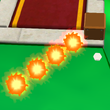
|
Fire Bar | Rotating bars of fireballs which burn Mario or Luigi upon contact. |

|
Fireball | Long trails of flame which fly through the air in circular patterns. Larger fireballs occasionally appear "jumping" out of lava. Smaller fireballs which roll along the ground can be summoned by Magikoopas and Kamella. |

|
Floating Mine | Spiked bombs which are typically immobile, although in a few galaxies they can move vertically or horizontally. Mines explode if bumped into, knocking Mario or Luigi back. They can be destroyed by shooting them with a Star Bit. |
| Floating Mine (underwater) | Underwater mines with eyes which bob up and down on chains. Underwater mines can regenerate after their detonation. | |

|
Freezing water | Icy water that causes Mario or Luigi damage if they swim in it for more than a few seconds. Freezing water can be frozen over using the Ice Flower, allowing the player to harmlessly skate across the water's surface. |

|
Goomba | Small shiitake-like creatures that try to chase and ram Mario or Luigi. Goombas can be defeated with a single jump. If spun or shot with a Star Bit, Goombas will flip over and spin on their head, allowing them to be kicked or stomped on. |

|
Koopa Troopa (green) | Green-shelled turtles which patrol the area, walking back and forth in a straight line. When jumped on, they retreat into their shells, allowing Mario or Luigi to pick up their Green Shell. Strangely, Koopa Troopas in Super Mario Galaxy use their pre-Super Mario World design of walking on all fours without wearing shoes. |

|
Koopa Troopa (red) | Red-shelled Koopa Troopas which crawl around in a circle. They drop Red Shells when defeated, which can home in on enemies when thrown. |

|
Lava | Molten lava that damages Mario or Luigi if they fall in, with the additional effect of causing them to frantically jump up and down on the lava's surface. |
| Lava Geyser | Fountains of lava which get in Mario and Luigi's way when jumping across lava. | |

|
Magikoopa | Koopa magicians which shoot fireballs at Mario and Luigi. Magikoopas possess the distinction of giving a single coin when spun or jumped on, whereas most enemies give Star Bits when defeated with a spin. |

|
Meteor | Fiery rocks which fall from the sky and crash into planets. Meteors typically appear in volcanic galaxies, and also make an appearance in Bowser's Star Reactor when Bowser shoots them out of his mouth to destroy the bridge to his arena. |

|
Micro Goomba | Smaller and weaker versions of Goombas. Unlike their larger counterparts, Mini Goombas can be defeated with a single spin. |

|
Piranha Plant | Immobile carnivorous plants which lash out at Mario or Luigi when they approach. Piranha Plants can be defeated with a spin or a stomp, and can be stunned by shooting a Star Bit at one. Occasionally, a Sproutle Vine will grow where a Piranha Plant is defeated. |

|
Poison | Poisonous liquid which costs Mario or Luigi a life if they fall in. |
| Pokey | A single red Pokey which only appears in Dusty Dune Galaxy. It attacks by attempting to slam its head into Mario or Luigi, while backing away from them. The Pokey can be defeated by destroying its body segments and then its head, or by stomping on its head from above. | |
| Pokey (big) | A giant, immobile Pokey which attempts to slam its head into Mario or Luigi. Only two Big Pokeys appear in the entire game; one in Good Egg Galaxy and the other in Dusty Dune Galaxy. Big Pokeys can be defeated by spinning a coconut at their body, and then stomping their overturned head. | |

|
Pokey Head | Green Pokey heads which bury their faces in the sand with their flowers visible on top. When Mario or Luigi arrive, they burst out of the ground and start hopping after them. Pokey Heads can be defeated in a single hit with a spin or stomp. |

|
Quicksand | Liquid sand which drowns Mario or Luigi as soon as they fall in. Quicksand is typically marked with a skull sign. |

|
Spike Trap | Spiked platforms which slide around on a set path, damaging Mario or Luigi if they touch its sharp edges. |

|
Spiny Cheep-Cheep | A spiky pufferfish which charges at Mario or Luigi upon sight, disappearing after a few seconds. Only two Spiny Cheep-Cheeps appear in the game; hidden within two chests in the Drip Drop Galaxy. |

|
Thwomp | Giant stone faces which drop down to crush Mario or Luigi, resulting in a life lost if they make contact. |

|
Torpedo Ted | Torpedo-like creatures which only appear in Buoy Base Galaxy and Drip Drop Galaxy. Torpedo Teds are fired from torpedo tubes and home in on Mario or Luigi much like Bullet Bills, exploding upon impact. They can be lured towards glass cages to break them. |

|
Torpedo tube | Underwater cannons which fire Torpedo Teds. |

|
Tox Box | Stone cubes which roll around in an attempt to flatten Mario or Luigi. However, they possess a square hole on one of their sides which Mario or Luigi can stand under to survive. Tox Boxes are the same width of the paths they travel, thus making them very difficult to avoid. |

|
Urchin | Amphibious spiky monsters which roll around chasing Mario or Luigi. Urchins can be defeated with a shell or fireballs shot by Fire Mario/Luigi. |

|
Wiggler | Yellow caterpillars which walk around in circles. If Mario or Luigi ground pound nearby a Wiggler or spin one, they flip over. If stunned Wigglers are not stomped after several seconds, they upright themselves and turn red. Red Wigglers furiously chase Mario or Luigi, calming back down to their yellow forms in a few seconds. Wigglers can be defeated in a single hit by ground pounding them. |

|
Whirlpool | Underwater vortexes which push Mario or Luigi away, rather than sucking them in as with previous games. |
Bosses
Sixteen bosses are in the game. Some of them are fought more than once. The numbers below include Prankster Comet encounters.
| Image | Boss | Times Fought | Image | Boss | Times Fought | Image | Boss | Times Fought | Image | Boss | Times Fought |
|---|---|---|---|---|---|---|---|---|---|---|---|

|
Dino Piranha | 2 | 
|
King Kaliente | 2 | 
|
Stink Bug Parent | 1 | Bugaboom | 1 | |

|
Megaleg | 1 | 
|
Kamella | 3 | 
|
Tarantox | 1 | Topmaniac | 4 | |

|
Bowser | 3 | Bouldergeist | 2 | Bowser Jr. | 1 | 
|
Major Burrows | 2 | ||

|
Baron Brrr | 1 | 
|
Undergrunt Gunner | 3 | 
|
Kingfin | 1 | 
|
Fiery Dino Piranha | 1 |
Items and objects
Throughout the game, Mario can use many new and returning items, many of which have unique properties.
| Item | Function |
|---|---|
 ? Coin |
A large coin that can make a multitude of things appear, including coins, Star Bits, notes, a power-up, or even another ? Coin. |
 ? Block |
A block that releases other items, such as coins, Star Bits, or power-ups, when hit from the bottom. |
 1-Up Mushroom |
Gives Mario an extra life. |
 Life Mushroom |
A mushroom that gives Mario's Health Meter an additional three sections, bringing the total to six. |
 Banandelion |
A dandelion-like plant that allows the player to launch off when they shake the Wii Remote enough. |
Beacon |
The star-like reactor that powers the Comet Observatory and grows as Mario collects Grand Stars. |
 Bob-omb Dispenser |
A machine that consistently dispenses Bob-ombs for use by the player. |
 Bolt Lift |
A set of rotating nuts that serve as a platform in industrial-themed galaxies. |
Bowser Statue |
Statues that release items when destroyed with Bullet Bills or Bomb Boos. |
 Brick Block |
Blocks that sometimes release coins when destroyed. |
 Bubble |
Air bubbles that refill Mario's air meter when collected underwater. |
Cannon |
Allows the player to aim and fire Mario to get to other planets. |
 Coconut |
Balls that can be used as projectiles to attack enemies and bosses, particularly Pokeys. |
 Coin |
Restore lost wedges of Mario's Health Meter. If 50 coins are collected, Mario gains an extra life. |
 Coin Block |
Blocks identical in appearance to Brick Blocks. They release coins repeatedly when hit. |
 Crate |
Often found in many different galaxies, these can be broken to release items or Goombas. |
Crystal |
A glassy crystal that can contain Star Bits, power-ups, or rarely, enemies and Toads. |
 Empty Block |
Blocks that are found in galaxies or created after a Coin Block is used. |
 Flipswitch Panel |
Floor tiles that trigger an event when Mario steps on all of them in an area. |
Floaty Fluff |
Flowers that Mario can hang onto to ride wind currents between areas. |
 Gold Shell |
A special, rare shell that is either given to the Coach (in the Beach Bowl Galaxy) or used to open a chest (in the Bigmouth Galaxy). It gives a large speed boost when used underwater. |
Gravity arrow |
Switches that change the direction of gravity when flipped. |
 Gravity field |
Colored walls that indicate the direction of gravity in an area. |
 Gravity spotlight |
Spotlights that pull Mario in when he stands under them. |
 Green Shell |
A green Koopa Shell that Mario can grab by touching it or spinning near it. The player can then throw it at enemies by shaking the Wii Remote. It gives a small speed boost underwater. |
 Ground-Pound Switch |
Switches that are activated by a ground-pound event. |
Key |
Keys that unlock Key Doors when collected. |
 Key Door |
Doors that are unlocked when Keys are collected. |
 Launch Star |
A powerful item that quickly launches Mario to another planet when the player shakes the Wii Remote near it. |
 Lever Switch |
Switches that reveal portions of the level required to progress. |
 Note |
Colorful musical notes that only appear after Mario has touched a ? Coin, after which a short trail of them appears in the immediate vicinity. When they are collected quickly, a short tune plays in the background. Collecting all of them causes either a power-up, a 1-Up Mushroom or a Power Star to appear. |
 Pull Star |
An item that pulls Mario towards it when the player positions the Star Cursor over it and presses the |
 Purple Coin |
A special variety of coin that only appears in galaxies when a Purple Comet is in orbit around a galaxy. |
 Red Shell |
A red Koopa Shell that Mario can grab by touching it or spinning near it. When Mario launches it, it homes in on any nearby enemies. It gives a larger boost than the Green Shell when used underwater. |
 Sling Pod |
A stretchy device that functions similar to a Sling Star, moving Mario to another area nearby. |
 Sling Star |
A smaller version of a Launch Star that flings Mario to another planet or area when the player shakes the Wii Remote near it. |
| File:SMG Asset Model Sproutle Vine.png Sproutle Vine |
A curved vine that Mario can slide on to reach another area. |
 Star Ball |
A ball that Mario must roll to the end of the stage to release the Power Star contained within it. |
 Star Bit |
One of the most common items in the game, Star Bits can be found almost everywhere and can be collected with the Star Cursor. Sometimes, Mario has to feed Star Bits to Hungry Lumas to advance. If 50 Star Bits are collected, Mario earns an extra life. |
Star Chip |
Small fragments of a Launch Star, Sling Star, or Pull Star. When all five have been found, they reform into their respective star and allow the player to advance. Yellow Star Chips are much more common than blue ones. |
 Stump |
Tree stumps that can be ground-pounded to release items or trigger events. |
 Trampoline |
Springs that bounce the player high in the air to reach items or platforms. |
 Treasure chest |
Chests containing items, Toads, or Power Stars. They are typically opened with Koopa Shells. |
Warp Pad |
Pads found on the Comet Observatory that carry Mario to hard-to-reach areas. |
Warp Pipe |
Pipes that transport the player between areas or inside planets. |
 Watermelon |
Projectiles similar to coconuts that can be thrown to defeat enemies. |
Power-ups
Mario regains his ability to attain different abilities via special mushrooms, flowers, and stars, similar to Super Mario 64, in which he could obtain the Wing Cap, the Vanish Cap, and the Metal Cap to gain new powers. In this game, Mario uses seven power-ups to gain new abilities.
| Power-Up | Transformation | Function |
|---|---|---|
 Bee Mushroom |
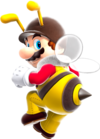 Bee Mario |
Allows Mario to fly for a short time when the |
 Boo Mushroom |
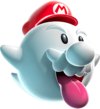 Boo Mario |
A mushroom that gives Mario the power of intangibility, and also allows him to float in the air with |
 Fire Flower |
 Fire Mario |
A power-up that allows Mario to throw fireballs at his enemies by shaking the Wii Remote. |
 Ice Flower |
 Ice Mario |
A power-up that allows Mario to freeze water or lava in small hexagonal ice platforms and skate across them freely. |
 Rainbow Star |
 Rainbow Mario |
A power-up that turns Mario into Rainbow Mario, thereby making him completely invincible for a short time. After running for a while with this power-up active, Mario's top speed increases. |
Red Star |
 Flying Mario |
A power-up that holds the power of the Red Luma. It allows Mario to fly for a limited time by spinning while in the air. The player can also hold |
 Spring Mushroom |
 Spring Mario |
A power-up that transforms Mario into Spring Mario, allowing him to bounce extremely high by pressing |
Power Stars
| Item | Function |
|---|---|
Grand Star |
A special type of Power Star that is needed to power the Comet Observatory. |
Green Power Star |
A very rare Power Star that can only be found in three galaxies in the game. They are used to unlock the Trial Galaxies. |
Power Star |
A regular star that Mario must collect to power up the various parts of the Comet Observatory and ultimately reach Bowser at the center of the universe. |
 Red Power Star |
An extremely rare Power Star that is guarded by the Red Luma. There is only one found in the entire game. |
 Silver Star |
A special star that is always found in sets of five in some galaxies. When Mario collects all five of them, they merge into a Power Star. |
Letters
At various points in the game, the Mailtoad gives the player a letter, which is sent to the Wii Message Board.
Whenever Luigi needs to be rescued after initially saving him from the Ghostly Galaxy, the letter says the following:
Dear Mario,
Oh, no! It's horrible!
Luigi has gone missing!
What will we do?!
Mailtoad
After rescuing Luigi each of these times, the letter says the following:
Dear Mario,
Thank you for saving Luigi! Keep trying to rescue those Power Stars, and we'll do our best to help! ♪
Mailtoad
After getting the 121st and final Power Star from the Grand Finale Galaxy, the letter will say the following:
Dear (Mii's name),
Congratulations! We would like to send you a galaxy sized thanks for saving all the Power Stars and playing to the very end.
Until next time;
The Super Mario Galaxy staff
Super Mario Galaxy Original Soundtrack
- Main article: Super Mario Galaxy Original Soundtrack
A soundtrack for the game was released called the Super Mario Galaxy Original Soundtrack. There is a one-disc edition and a two-disc Platinum edition. It was exclusive to Club Nintendo members in Japan and Europe. The one-disc version was also included in certain bundles of the Wii in 2010 that also contained Wii Sports and New Super Mario Bros. Wii.
Development
Super Mario Galaxy finds its roots in the Super Mario 128 demo.[7] Yoshiaki Koizumi, the director of the demo, wanted the part where Mario moves freely around a saucer-shaped platform to be included in an actual game, but found that implementing the concept would be technically demanding.[7] Shigeru Miyamoto remained interested in the concept, and after Donkey Kong Jungle Beat's completion, asked the newly formed EAD Tokyo if they wanted to make a high-profile game starring established Nintendo characters, which led to one of the staff member suggesting that they had the skillset to make a Mario game.[7] Yoshiaki Koizumi felt that the Jungle Beat team had the ability to make spherical platforms work and said that he wanted to make the game for the Wii.
Koizumi then gathered several other members in order to create a prototype. The outer space theme was chosen due to him finding that most players would interpret spherical shapes as planets,[7] and gravity was added. The prototype was shown to Nintendo after three months of development, which approved it.
Although Miyamoto was not working full time at EAD Tokyo, he frequently visited the studio to share ideas and oversee development. One of his suggestions was to include a delay between spinning instead of having Mario spin continuously by shaking the Wii Remote, so that the game would be more challenging and interesting to play.[7] A setup was eventually created so that both the Kyoto and Tokyo offices could playtest the game.
The development team made heavy use of play-testers due to the studio's experience while developing Donkey Kong Jungle Beat.[7] One of Koizumi's main concern were the camera angles and the motion sickness they caused. He thought camera-induced motion sickness was a problem with 3D action games, and found neither Super Mario Sunshine nor Donkey Kong Jungle Beat's solutions satisfying.[7]
EAD Tokyo was pressured to finish the game close to the Wii's launch, as several executives were disappointed by Super Mario Sunshine not being a Nintendo GameCube launch title and thought that an earlier release could have helped the GameCube's commercial performance. However, EAD Tokyo decided that making a polished Mario game was more important.[7]
Promotion
- Main article: List of Super Mario Galaxy trading cards
Trading cards were released to celebrate the release of Super Mario Galaxy. These helped amplify the publicity of the game. Each booster pack would have two regular cards, one trivia card, one standee, and one FunTat.
Reception
Super Mario Galaxy has been met with universal acclaim, receiving a GameRankings score of 97.64% from 78 reviews, making it the highest rated game on the website, while scoring a 97/100 on Metacritic, as of March 2019 the sixth-highest score on the website.
Famitsu Magazine has given Super Mario Galaxy a score of 38/40.[8] The Official Nintendo Magazine UK gave the game 97%. It was called the best game of the decade and praised for having excellent graphics, sound and gameplay as well as a mixture of new features and classic features.[9] Australia's longest-running unofficial multi-format gaming magazine, Hyper, scored the game 97 out of 100, tied for the highest score ever given in the history of the magazine, running since 1993.
| Reviews | |||
|---|---|---|---|
| Release | Reviewer, Publication | Score | Comment |
| Wii | Aaron Linde, Destructoid | 9.6/10 | "To say that they've succeeded almost isn't enough; Super Mario Galaxy is so incredible that it improves upon flaws in Mario 64 that I hadn't even noticed until, y'know, Galaxy did it better. And though there's little in the way of "innovation" of the genre, it's the refinement of the genre that solidifies Galaxy as the most essential platforming experience yet created." |
| Wii | Edge | 10/10 | "Since the end of the N64 era, as Nintendo has explored new pastures and methodically tended old ones, it's been easy to forget the times when every major release from the company felt like this. It's a bravura piece of design that pulls off stunts no one else has even thought of." |
| Wii | Margaret Robertson, Eurogamer | 10/10 | "The great challenge in making a follow-up to Mario 64 was always that to do it justice, you'd have to make a game which is as much its own as Mario 64 was. That's no easy task when you also have to integrate the traditions of two decades of Mario games and the expectations of millions of fans. Sunshine, despite its dazzle, ultimately collapsed under that weight, becoming repetitive and sometimes cumbersome as it tried to find the balance. Where Galaxy matches Mario 64 is not quite in its quality of execution - alongside the brilliance of some stars are others which fall a bit flat, and there isn't the overall sense of implacable perfection that that game had - but in its confidence and originality. Another decade needs to go by before we'll know whether it will come to be as revered as 64 did. For now, all that matters is that the waiting is finally over." |
| Wii | Alex Navarro, GameSpot | 9.5/10 | "The stellar presentation and fantastic level designs combine to make Super Mario Galaxy the Wii's game to beat and one of Mario's greatest adventures yet." |
| Wii | Matt Casamassina, IGN | 9.7/10 | "Galaxy isn't quite perfect. There are some minor issues -- tiny blemishes, if you will, hiding on the backside of a supermodel. There's the auto-camera, which works exceptionally well most of the time, but every so often stumbles. And there's the overall difficulty -- a little too easy to 60 stars and to defeat bosses for my tastes. But even with these potential drawbacks, Nintendo's Tokyo studio has created a platformer that deserves its place among the very best and will surely be remembered in another decade as a classic." |
| Wii | Anthony Dickens, Nintendo Life | 10/10 | "Super Mario Galaxy is a fantastic game, a game that displays Nintendo's continuing ambition to explore the possibilities of a 3D platformer, something that no-one else has really managed to do. It's considerably better than Super Mario Sunshine on all accounts, with the new emphasis on gravity it becomes once again a game that requires skill and timing rather than just an exploratory mind. This will be an instant hit and surely go down as one of the best Mario games. A must have for all." |
| Wii | Tom Orry, VideoGamer | 9/10 | "In the hands of anyone who's been longing for a true sequel to Mario 64, Super Mario Galaxy could well be the game of the year, but it's nowhere near as revolutionary as Mario 64." |
| Aggregators | |||
| Compiler | Platform / Score | ||
| Metacritic | 97 | ||
| GameRankings | 97.64% | ||
Awards and recognition
Super Mario Galaxy received Game of the Year in 2007 from IGN[10], GameSpot[11], Kotaku[12], and Yahoo! Games.[13] Australian magazine Hyper also named Super Mario Galaxy as Game of the Year in 2007 as voted by its readers.[citation needed]
In 2007, the game won an award for "Best Audio Design” from Edge.[14] In February 2008, the game received the "Adventure Game of the Year" award from the Academy of Interactive Arts & Sciences at the Interactive Achievement Awards.[15]
In 2009, the game won “Best Game” at the 5th British Academy Games Awards.[16] That same year, Guinness World Records ranked Super Mario Galaxy 29th in their list of top 50 console games of all time based on initial impact and lasting legacy.[17]
The game placed 51st in the 200th Issue of GameInformer's "Top 200 Games of All Time".[18] Nintendo Power ranked it as best Mario mainstream title in its May 2012 issue,[19] as well as the third-best game ever released on a Nintendo console in its final issue.
Sales
Super Mario Galaxy has been a commercial success, selling 350,000 units in Japan within its first few weeks of sale.[20] In the United States, the game sold 500,000 units within its first week of release, earning it the highest first-week sales for a Mario game in the country at the time.[21]Super Mario Galaxy is the 8th best-selling game for the Wii, selling 12.72 million copies worldwide as of September 2017.[22]
Super Mario 3D All-Stars description
- "It's the night of the Star Festival, and Star Bits are falling from the sky! As everyone celebrates, Bowser suddenly appears and lifts the castle—and Princess Peach—into space, leaving Mario stranded in orbit! It's here that Mario meets a curious star child, Luma, and a mysterious woman in blue...This game introduced new ways to control Mario, like pointing and shaking the Wii Remote, as he explores miniature planets with fun forms of gravity."
Media
- For a complete list of media for this subject, see List of Super Mario Galaxy media.
Gallery
- For this subject's image gallery, see Gallery:Super Mario Galaxy.
Luigi, Rosalina, Captain Toad and the Toad Brigade
Quotes
- Main article: List of Super Mario Galaxy quotes
Bowser
- "Princess Peach! You are formally invited...to the creation of my new galaxy! Gwahahaha! This festival's over!"
- "BWAHAHAHA! You finally made it! Just in time for me to stomp you into space bits!"
- "WHAA--?! IT'S YOU! That's it, Mario! I'm gonna stomp you into space bits!"
- "Finally! You got here just in time to see the creation of my galaxy in the center of the universe! WATCH AND WEEP! From this galaxy, I'll rule a great galactic empire with Peach by my side. It will last forever! I will rule every pitiful corner of the universe. So, Mario, as you can see, I got big plans. And stomping you is at the top of my list!"
- "NOOOOO! My galaxy! My empire! This can't be happening..."
Queen Bee
- "And who might you be? A physician, we presume? No matter. We are in the most vexing predicament and require assistance. The most furious itchiness plagues our entire being! It must be stopped! Please find the source at once!"
- "Yes that's the ticket!"
- "Ah...that feels goooood!"
- "Ahoo hoo! That tickles!"
- "My thanks! You have shown much bravery, New Bee. We trust that we may rely on you in the future!"
- "The neighbors are causing trouble again. We would be most grateful for your assistance!"
Pre-release and unused content
Rosalina was intended to be related to Princess Peach, and Rosalina had a very similar appearance reflecting this. Bonefin Galaxy was intended to be much darker, as was Deep Dark Galaxy. These were changed in the interest of playability. Guppy was originally a dolphin, and a friendly character. Some art of the Sea Slide and Beach Bowl Galaxies suggests that they were conceived as a single galaxy, with beach bowl's main planet in the center of Sea Slide's ring. A piece of concept art labeled only "fortress" is captioned as a piece that is very memorable to the SMG development team, since it was one of the earliest drawings of Galaxy. Ironically, the planet shown in the art is nowhere in the final game.
Controversy
Super Mario Galaxy was the first Mario game to be officially localized to French for Quebec; that market had previously received Mario titles in English rather than French. This followed a deal between the Office québécois de la langue française and the video game industry to have every game available for that region in French by 2009. In the Quebec localization, NPCs (particularly the Lumas and the Toad Brigade) make heavy use of Joual accents and slang. This localization choice sparked a minor controversy, with representatives of the OQLF and the Union des artistes criticizing it for promoting poor literacy to children.[23] A Nintendo representative responded that the localization was made with "localizing for the market" in mind, as the Quebec market made up 25% of sales for Nintendo of Canada at the time.[23]
Following the negative reception to the localizations of Super Mario Galaxy and The Legend of Zelda: Phantom Hourglass (which featured a similarly Joual-heavy localization), later Canadian French localizations would be written in Standard French (with the exception of the similarly-localized Paper Mario: Sticker Star, as well as the Pokémon series which would simply retain its European French localizations and corresponding slang).
Glitches
- Main article: List of Super Mario Galaxy glitches
Out of bounds in Freezeflame Galaxy
To perform this glitch the player should go to the Freezeflame Galaxy's mission Hot and Cold Collide. Mario should reach the second planet and triple-jump in the walkway between the sides of the planet. The player should use the slope-climbing glitch to reach the top of the planet. When the player walks on the planet, random textures of ice water will appear. The planet surface will also appear in the wrong spot or be invisible.
Bowser's Star Reactor death glitch
When the player enters Bowser's Star Reactor they must get to the end of the Loop Planet and get on the platform. If they do a long jump toward the Gravity Planet while the platform is moving, Mario will fall towards the gravity planet and die, tumbling as if he went into a black hole.
Staff
- Main article: List of Super Mario Galaxy staff
A team of 100 individuals were involved in the development and publishing of Super Mario Galaxy, not counting those who merely localized the game for American and European audiences. The game's diverse staff ranged from Mario franchise veterans to newcomers.
Shigeru Miyamoto conceived the game and was its co-producer with Takao Shimizu. Yoshiaki Koizumi was the director and chief designer. The level design was directed by Koichi Hayashida, the programming by Naoki Koga, and the sound by Masafumi Kawamura. Characters original to the game were designed by a team of six people — Atsushi Mishima, Daisuke Watanabe, Rikuto Yoshida, Masanori Esaki, Kazuhiro Saito, and Takumi Ishii. Koji Kondo co-wrote the game's soundtrack with Mahito Yokota.
This is the first Super Mario game to feature Bowser's current voice actor, Kenny James.
The staff credits in the Nvidia Shield edition shows three people in charge of Chinese localization, as well as an "iQue testing group" for testing. It is possible that the game was fully translated for the iQue Wii release before the console was canceled.[24]
References to other games
- Super Mario Bros. - Several sprites from this game appear here, including a planet in the Toy Time Galaxy, Mario sprites being in the background of a particular Bowser galaxy, and the background of the Flipswitch Galaxy which has scenery of the overworld and underground levels. Also, Toy Time Galaxy's music is a rearrangement of the overworld theme from this game. Several galaxies use a remix of a small portion of the underground theme from this game. Also, an arrangement of the underground theme is used for several galaxies, starting with Flipswitch Galaxy. Some of the musical notes are music from the game such as the underground theme and the underwater theme.
- Super Mario Bros.: The Lost Levels - Luigi's higher jumping and lower traction returns.
- Super Mario Bros. 3 - Several music tracks from this game are rearranged here. Airships also return.
- Dr. Mario - A planet shaped like a giant Megavitamin cameos.
- Super Mario World 2: Yoshi's Island - Rainbow Mario's theme is an orchestral remix of Superstar Mario's theme from this game.
- Super Mario 64 - Tox Boxes and Bomps from this game return. The music of some Bowser galaxies are rearranged from Super Mario 64. In both games, after the credits and an ending screen is displayed, Mario would say "Thank you so much for playing my game!".
- Paper Mario - Both games begin with a letter being sent from Peach to Mario. Also, Bowser's way of kidnapping Peach (by lifting the entire castle into the sky) is reused here. They also have stories of baby stars.
- Luigi's Mansion - When the player first sees Luigi, he is trapped in a Ghost House. Mario freeing him is a direct spoof of Luigi's Mansion, as in Luigi's Mansion it was the direct opposite. Also, the music that is being played when a boss tower is unlocked sounds suspiciously like the Luigi's Mansion "Dark Room" theme.
- Super Mario Sunshine - Fire Pressures and Water Shooters, which appear in various galaxies, have a strong resemblance to F.L.U.D.D.'s nozzle. The goal in the Loopdeeloop Galaxy and the Loopdeeswoop Galaxy is also shaped in a Shine Sprite. Blue Cataquacks are present in two galaxies.
- Super Mario 64 DS - The Silver Stars from this game return in Super Mario Galaxy.
- Donkey Kong Jungle Beat - The flowers that Donkey Kong flings off of were reused in Super Mario Galaxy.
- Mario Party 7/Mario Party 8 - If a Dry Bones falls into quicksand in Dusty Dune Galaxy, the cry Dry Bones makes when it is "blown away" in these games can be heard.
References in later games
- Super Smash Bros. Brawl - Super Mario Galaxy appears listed in the game's Chronicles, despite of none of the actual contents were being used.
- Mario Kart Wii - Rosalina can be unlocked by having save data from Super Mario Galaxy. The Rainbow Road course is set in space and is full of Star Bits; a portion of its music is based on the Good Egg Galaxy's theme. Spiky Topmen were bosses in multiple online tournaments, and finally, the countdown sequence for starting a minigame returns as the official sequence for starting races and battles in this game.
- Mario & Luigi: Bowser's Inside Story - The spike ball move used by Bowser in the last boss fight returns in this game.
- Mario & Sonic at the Olympic Winter Games - Both the Individual and Team versions of Dream Ski Jumping take place in the Good Egg Galaxy. A few music tracks from Super Mario Galaxy can be bought.
- New Super Mario Bros. Wii - During the credits, Peach can be heard reading the letter she sends to Mario at the beginning of Super Mario Galaxy.
- Super Mario Galaxy 2 - This is the sequel to Super Mario Galaxy with the engine reused, with many elements returning such as the reused voices, while others are new.
- Super Mario 3D Land - The haunted house theme and the arrangement of the Airship Theme are reused. Several other music tracks and voice clips from Super Mario Galaxy were reused for this game.
- Mario & Sonic at the London 2012 Olympic Games - Dream Spacewalk is heavily inspired by Super Mario Galaxy, featuring Dino Piranha as a boss in the Synchro Battle Galaxy, a location based on elements of the Good Egg Galaxy and Gateway Galaxy as well as the Sky Station Galaxy from Super Mario Galaxy 2. The event also features sound effects from Super Mario Galaxy and uses the spin attack in combat. Dream Hurdles takes place in the Battlerock Galaxy. Rearrangements of several tracks appear in the game, including Dino Piranha's theme, the Battlerock Galaxy and the Purple Coins music. A Mii outfit based on Bee Mario can be unlocked in the game, and Mario's special dash has also been updated to resemble the spin attack.
- Mario Kart 7 - On the Rosalina's Ice World course, the Comet Observatory is visible in the background. Also, Queen Bee can be unlocked as a playable character in this game.
- Mario Party 9 - The Ground-Pound Switch icon appears on Wiggler's body segments and on Whomp's back. Also, the music of some Bowser Jr. minigames is a rearrangement of Bowser Jr.'s theme of this game.
- Mario Tennis Open - The Comet Observatory appears as an unlockable court. The music played is an arrangement of the original theme and the music for the special game Galaxy Rally is an arrangement of the Good Egg Galaxy theme. Also, in the title screen, the player can see the Comet Observatory in the background.
- Mario Party: Island Tour - Rocket Road is based on the Comet Observatory. Also, Rosalina and the Lumas appear on this board. The minigame Gyro for the Gold plays very similarly to the Star Ball.
- Super Mario 3D World/Super Mario 3D World + Bowser's Fury - There are secret underground rooms where the player can collect sequences of coins for a limited time and receive a prize if all coins are collected. In the promotional spread, a silhouette which appears to be the Comet Observatory can be seen in the stars behind Bowser's Highway. The Light Boxes' light can defeat ghosts like in this game. Rosalina's special ability is the spinning ability Mario uses. Super Galaxy, a stage based off of the Super Mario Galaxy games appears, and so do Octoombas and the Comet Observatory. The Comet Observatory theme (3rd version) plays in the World Crown map area, while an arrangement of Gusty Garden Galaxy's theme can be heard in Honeycomb Starway, Honeycomb Skyway, and Champion's Road. The overworld map of World Star has Star Bits in the background. Also, the Toad Brigade theme is reused on the Captain Toad levels. Also, sound effects from Super Mario Galaxy are reused.
- Mario Golf: World Tour - Mario's Star uses elements from Super Mario Galaxy such as Star Bits. The music used in Wiggler Park uses a rearrangement of Honeyhive Galaxy's music.
- Mario Kart 8/Mario Kart 8 Deluxe - An image of a Luma can be seen from an airplane (from Galaxy Air airlines) at the Sunshine Airport course, as well as on the Star Cup trophy. Also, part of Cloudtop Cruise's music is an arrangement of Gusty Garden Galaxy's music.
- Super Smash Bros. for Wii U - There is a stage based on this game and Super Mario Galaxy 2, with the Starship Mario and Airship appearing in the background of the main stage. Rosalina is playable in this game, and her moves use objects from Super Mario Galaxy, such as Star Bits and Launch Stars.
- Puzzle & Dragons: Super Mario Bros. Edition - Mario's Bee and Boo forms appear in this game as Helpers for the player's team, as well as Rosalina. Gusty Garden Galaxy's music is used for this game's credits.
- Super Mario Maker - The victory and death themes from Super Mario Galaxy are used when the Rosalina costume completes a level or loses a life, respectively.
- Mario Party: Star Rush - Gusty Garden Galaxy's theme appears as one of the songs in the Rhythm Recital mode for this game.[25]
- Mario + Rabbids Kingdom Battle - Bee Mushrooms can be found on tubes of honey. Peach shouting for Mario from this game can be heard whenever she is defeated in battle.
- Super Mario Odyssey - A sprite of Rosalina can be found in the Dark Side and Darker Side. The jingle that plays when Mario collects a new power-up is reused for when the Odyssey is restored. Peach's call to Mario from this game is heard during the opening sequence after Mario is knocked off of Bowser's airship, but in a higher pitch. The regional coins in the Moon Kingdom are based on the shape of Star Bits.
- Super Smash Bros. Ultimate - The Mario Galaxy stage returns in this game. Boo Mario, Luma, Hungry Luma, and Queen Bee appears as spirits using their artwork from Super Mario Galaxy.
- Super Mario Maker 2 - A sound effect that plays Gusty Garden Galaxy's theme is available.
Names in other languages
| Language | Name | Meaning |
|---|---|---|
| Japanese | スーパーマリオギャラクシー Sūpā Mario Gyarakushī |
Super Mario Galaxy |
| Chinese (simplified) | 超级马力欧银河[28] Chāojí Mǎlìōu Yínhé |
Super Mario Galaxy |
| Chinese (traditional) | 超级瑪利歐銀河[27] Chāojí Mǎlìōu Yínhé |
Super Mario Galaxy |
| Korean | 슈퍼 마리오 Wii 갤럭시 어드벤처[26] Syupeo Mario Wii Gaelleoksi Eodeubencheo |
Super Mario Wii: Galaxy Adventure |
Trivia
- The save data description is "Launch into a cosmic adventure!"
- Sixteen years before its release and by coincidence, the title "Super Mario Galaxy" was first mentioned in a fan letter written to Nintendo Power by Jimmy Peterford of Glen Cove, New York. The letter in question, which was printed in the December 1991 issue, detailed a fantasy game system called the "Raw Power System," which would come bundled with a game named "Super Mario Galaxy," but in Peterford's words, would be "better known as Super Mario Bros. 24!"[29]
- Due to a mixup involving GameStop, the automated phone message sent to those who preordered the game stated Super Mario Galaxy to be a Mature-rated game.[30]
- The Nvidia Shield version of Super Mario Galaxy showed copyright information "© 2007-2008 Nintendo". It was unknown what 2008 means in this context, possibly the year Super Mario Galaxy was planned for release on the iQue Wii before the console failed to make its way into the Chinese market.[31]
- The galaxy image in the Super Mario Galaxy title is an edited version of the photograph Robert Gendler took of the Andromeda Galaxy in 2005.[32]
- Despite Super Mario Galaxy receiving an official China (Simplified Chinese) release on Nvidia Shield, localized by iQue, Super Mario 3D All-Stars does not include Chinese script in-game and only offers menu translation for the Chinese-speaking audience.
- The Nvidia Shield TV version lacks the option to use Miis as a save icon due to the Nvidia Shield TV not using Miis. This change is carried over to the 3D All-Stars version even though the Nintendo Switch still supports the creation and use of Miis in games.
References
- ^ [1]
- ^ Nintendo (September 3, 2020). Super Mario Bros. 35th Anniversary Direct. YouTube. Retrieved September 3, 2020.
- ^ https://www.youtube.com/watch?v=eRantJ0Acm8 Co-Star Super Jump after backflip or triple jump
- ^ リンカー. October 6, 2011. スーパーマリオギャラクシーを実況プレイ Part52. YouTube. Retrieved October 27, 2019.
- ^ https://twitter.com/jhstjh/status/978431140959805440
- ^ https://twitter.com/chinesenintendo/status/1019812333621669888
- ^ a b c d e f g h Iwata Asks: Super Mario Galaxy (accessed March 07 2012)
- ^ http://www.nintendolife.com/news/2007/10/famitsu_gives_super_mario_galaxy_3840
- ^ https://purenintendo.com/nintendo-magazine-uk-super-mario-galaxy-review/
- ^ https://web.archive.org/web/20080113203707/http://bestof.ign.com/2007/overall/25.html]
- ^ https://web.archive.org/web/20091130095636/http://www.gamespot.com/best-games-of-2007/gameoftheyear/index.html?page=2
- ^ https://web.archive.org/web/20121008051051/http://kotaku.com/338725/kotakus-overall-game-of-the-year]
- ^ https://web.archive.org/web/20071224063905/http://videogames.yahoo.com/events/game-of-the-year-2007/best-overall-game-of-2007/1177115/2
- ^ https://web.archive.org/web/20121018165751/http://www.edge-online.com/features/edge-awards-2007/3/
- ^ https://web.archive.org/web/20080213222404/http://www.nintendo.com/whatsnew/detail/LDsHV_120iafJ387QDMH-z467zT5F5r1
- ^ https://www.engadget.com/2009/03/11/super-mario-galaxy-voted-best-game-by-bafta/
- ^ https://web.archive.org/web/20090304054942/http://www.computerandvideogames.com/article.php?id=209385
- ^ https://www.giantbomb.com/profile/dantebk/lists/game-informers-top-200-games-of-all-time/32009/
- ^ http://gamingrockson.blogspot.ae/2012/05/nintendo-power-ranks-super-mario-series.html?m=1
- ^ https://www.wired.com/2007/11/super-mario-gal/amp
- ^ https://www.tomshardware.co.uk/Wii-Mario-Nintendo,news-26933.html
- ^ https://www.nintendo.co.jp/ir/en/finance/software/wii.html
- ^ a b Nouveaux jeux Nintendo: un français lamentable
- ^ https://twitter.com/chinesenintendo/status/980318144131620864
- ^ NintenDaan. September 22, 2016. [Mario Party: Star Rush] Rhythm Recital Gameplay 2. YouTube. Retrieved September 24, 2016.
- ^ Super Mario Galaxy Korean Trailer
- ^ 《超級瑪利歐64》、《超級瑪利歐陽光》和《超級瑪利歐銀河》。3款歷代的3D瑪利歐收錄在Nintendo Switch的《超級瑪利歐 3D 收藏輯》,將於9月18日發售! Nintendo HK. Retrieved September, 2020.
- ^ https://shield.nvidia.cn/games/geforce-now/supermariogalaxy
- ^ Nintendo Power, Volume 31, Page 6.
- ^ Super Mario Galaxy - rated Mature?!, retrieved 12/30/2015
- ^ https://twitter.com/chinesenintendo/status/977408083176509441
- ^ https://twitter.com/CometMedal/status/1296637781842722822
External links
- Japanese Website
- American Website
- European Website
- Korean Website
- Chinese Website (From Nvidia)
- Prologue Video (IGN)
- Super Mario Galaxy Reviews, Guide, Videos, Screenshots and more! (IGN)
- Super Mario Galaxy (Gamewise)
